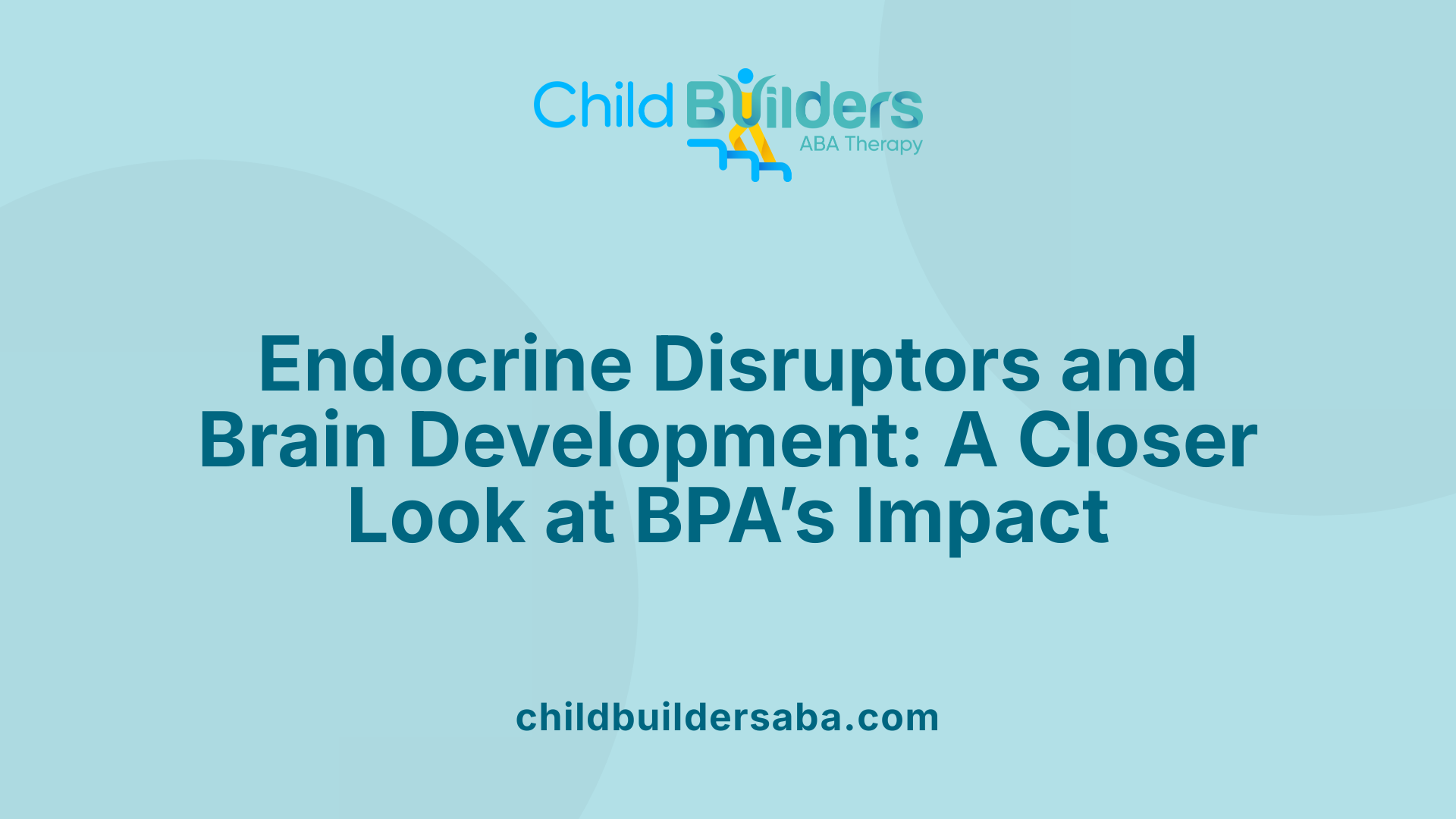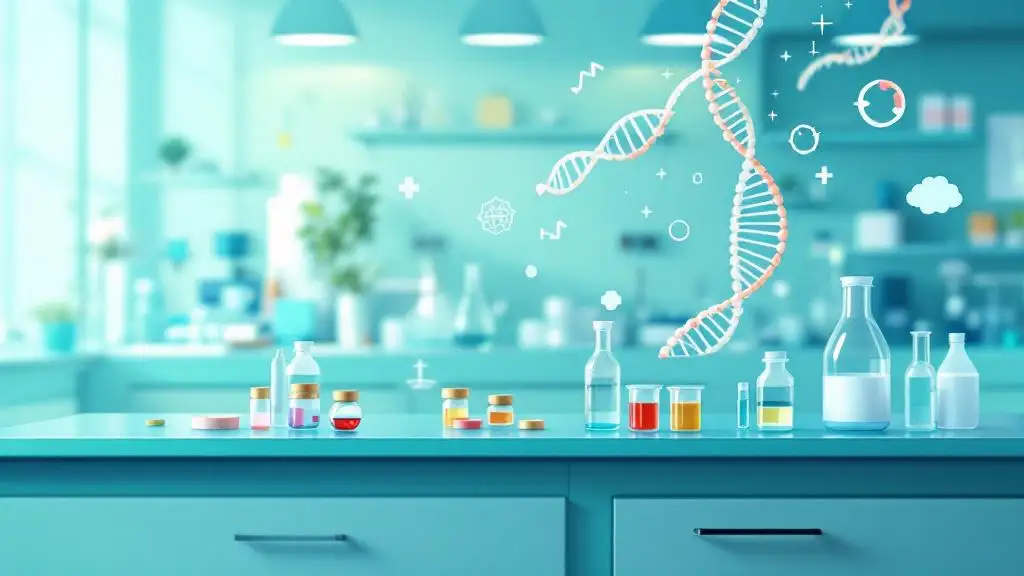Do Plastic Toys Cause Autism?

Understanding the Link Between Plastic Chemicals and Autism
The question of whether plastic toys contribute to autism spectrum disorder (ASD) has garnered significant public interest. Although current scientific evidence does not support a direct causal relationship between plastic toys and autism, research highlights the presence of certain chemicals in plastics, such as bisphenol A (BPA) and phthalates, which could influence neurodevelopmental processes if exposure occurs during critical periods like pregnancy. This article explores the scientific findings on chemical exposure from plastics, particularly in toys, and their potential impacts on autism risk, along with guidance for parents seeking safe and eco-friendly options.
The Role of Chemicals in Plastic Toys and Their Potential Impact on Autism

What chemicals are in plastics, like BPA and phthalates?
Many plastics contain chemical compounds such as Bisphenol A (BPA) and phthalates. BPA is used to make polycarbonate plastics and epoxy resins, which line food cans and are found in some bottles and clear plastic products. Phthalates are chemicals added to plastics to increase flexibility and durability, often found in toys, vinyl flooring, and personal care products.
These chemicals are widespread due to their low cost and useful properties in manufacturing. Unfortunately, their prevalence means humans often encounter them from everyday products, sometimes without knowing. Studies highlight how these substances can seep into food, liquids, and aerosols, entering our bodies through ingestion, inhalation, or skin contact.
How do these chemicals mimic hormones and disrupt brain development?
BPA and phthalates are classified as endocrine-disrupting chemicals (EDCs). They can mimic natural hormones such as estrogen and androgens—stem from the human endocrine system that regulates growth, development, and reproduction.
BPA, for instance, mimics estrogen, a hormone critical in brain development and reproductive health. When BPA binds to hormone receptors, it can interfere with normal hormonal signals. This disruption is especially concerning during fetal development and puberty, when hormonal pathways are highly active.
Research indicates that BPA can suppress the enzyme aromatase in the brain—an enzyme essential for converting testosterone into estrogen. This suppression hampers normal brain development, particularly influencing circuits related to social behavior and cognition.
Similarly, phthalates can also interfere with hormone signaling, impacting neurodevelopment and behavioral outcomes. The interference during key developmental windows may lead to long-term effects on brain function and behavior.
Overview of studies linking prenatal chemical exposure to autism
Recent scientific studies have established environmental exposure to these plastics chemicals as a potential factor in neurodevelopmental disorders like autism. Large cohort studies, including research from Australia and the United States, have analyzed blood and urine samples from pregnant women and followed their children over years.
A notable study published in Nature Communications examined the association between maternal BPA levels during late pregnancy and autism spectrum disorder (ASD) in children. The findings revealed that higher BPA levels in mothers increased the likelihood of autism symptoms and confirmed diagnoses, especially in boys.
The biological mechanism involves BPA’s suppression of aromatase, a key enzyme that converts testosterone into estrogen in the developing brain. When aromatase activity is reduced, it can lead to abnormal brain structural development and altered neurobehavior, which are characteristic of ASD.
Laboratory experiments on mice further support these findings. Prenatal BPA exposure led to anatomical changes, neurological disruptions, and behavioral traits akin to autism spectrum disorder. These animal models are instrumental in understanding how chemical exposure impacts neurodevelopment.
The vulnerability seems particularly high in boys with lower brain aromatase levels. These individuals are more susceptible to BPA’s disruptive effects on hormone pathways.
In addition to autism, prenatal BPA exposure has been linked to other health risks such as behavioral issues, cognitive deficits, and increased cancer risk over a lifetime. The emerging evidence underscores the urgent need for regulatory measures to limit chemical exposure during pregnancy.
Precautionary measures and future research
Given these findings, health authorities recommend practical precautions for pregnant women and children. These include avoiding heating food in plastic containers, choosing glass or stainless steel over plastic, and steering clear of plastic toys labeled with phthalates or BPA. Additionally, avoiding scented products and plastics that leach chemicals is advised.
Ongoing research aims to find potential treatments and mitigation strategies. For instance, compounds like 10-hydroxy-2-decenoic acid are under investigation for their capacity to counteract BPA effects in animal studies.
Scientists continue to explore the complex pathways through which endocrine-disrupting chemicals influence neurodevelopment. As understanding deepens, regulations are being adapted to better protect vulnerable populations.
| Chemical | Common Uses | Potential Health Effects | Notable Studies |
|---|---|---|---|
| BPA | Cans linings, bottles | Autism spectrum disorder, hormonal disruption | Nature Communications study, Mouse experiments |
| Phthalates | Toys, vinyl products | Autism behaviors, hormonal effects | Recent cohort studies, Animal research |
| Precautionary Tips | - | - | Use glass containers, avoid scented products |
This evolving landscape of research emphasizes the importance of cautious exposure, especially for pregnant women and young children. Protecting these vulnerable groups from endocrine-disrupting chemicals might reduce the risk of neurodevelopmental disorders and improve overall health outcomes.
Understanding How Endocrine-Disrupting Chemicals Like BPA May Affect Brain Development

How does BPA mimic estrogen and disrupt hormone signaling?
Bisphenol A (BPA), a chemical found in many plastics, is known to mimic estrogen, one of the body's primary sex hormones. Because of this, BPA can interfere with the hormones that regulate various bodily functions. It binds to estrogen receptors in cells, acting as an endocrine disruptor. This mimicry can distort normal hormonal signaling, especially during critical periods of brain development, such as fetal growth and early childhood.
When BPA attaches to these receptors, it can alter the natural balance of hormones that influence brain formation. The disruption may lead to lasting changes in brain structure and function, which are associated with behavioral issues and neurodevelopmental disorders.
The biological pathway involving BPA, aromatase enzyme, and neurodevelopment
One of the major ways BPA impacts brain development is through its effect on the enzyme aromatase. Aromatase plays a crucial role in converting androgens (male hormones like testosterone) into estrogens within the brain. This process is vital for normal development, especially in male fetuses, where estrogen influences brain differentiation.
Research has shown that BPA exposure can suppress aromatase activity. When this enzyme is inhibited, the conversion of testosterone into estrogen decreases. As a result, the brain may not develop the typical hormonal environment needed for healthy neurodevelopment. This suppression particularly affects male fetal brains, which rely more heavily on this process.
Increased BPA levels during pregnancy have been linked to reduced aromatase activity and a higher likelihood of autism spectrum disorder (ASD) symptoms in boys. The disruption of hormone balances in the developing brain might be a key biological pathway through which BPA contributes to neurodevelopmental issues.
Insights from recent research: animal studies and birth cohort data
Several studies support the connection between BPA exposure and neurodevelopmental outcomes. Animal experiments, particularly with mice, have demonstrated that prenatal BPA exposure suppresses aromatase and causes behavioral, neurological, and anatomical changes similar to those seen in ASD. These models help illustrate how BPA’s interference with hormone production can lead to lasting impacts.
Complementing animal data, large-scale human cohort studies from Australia and the USA have provided evidence linking BPA levels in pregnant women to autism symptoms in their children. For instance, higher maternal BPA levels during late pregnancy were associated with increased risks of autism diagnoses by age 11, especially in boys with lower aromatase activity.
These findings highlight a biological pathway: BPA suppresses aromatase, disrupting hormone-driven brain development, and increasing ASD risk. The convergence of animal and human data strengthens the case for regulatory measures and public awareness.
| Study Type | Key Findings | Implications |
|---|---|---|
| Animal models | BPA suppresses aromatase, causes ASD-like behavior | Demonstrates biological impact of BPA on development |
| Human cohorts | Higher maternal BPA correlates with ASD in boys | Suggests real-world developmental risks |
| Regulatory assessments | Current levels in plastics are low but unwarranted | Calls for cautious use and further research |
As research advances, understanding these biological pathways informs safer practices and potential treatments, with some studies exploring compounds like 10-hydroxy-2-decenoic acid to counteract BPA effects.
Are chemicals like BPA in plastic toys harmful to children?
While BPA is used in some plastic toys, current assessments consider the levels present in toys to be safe based on existing regulations. The Toy Association states these levels are very small and are not intended for food contact, making the risk minimal.
Regulatory agencies, including in Europe, have concluded that BPA in toys does not pose significant health threats at the amounts typically encountered. No federal or state restrictions on BPA in toys are currently in place.
However, because BPA is an endocrine disruptor, it can interfere with hormonal development, especially in infants and young children who are more vulnerable. Evidence suggests potential long-term health issues such as immune, reproductive, and neurodevelopmental problems.
To reduce exposure, parents are encouraged to select toys labeled as free from harmful chemicals, including BPA. Using glass containers instead of plastic for heating food and avoiding scented products or plastic toys during pregnancy can offer additional protective steps.
This ongoing research underscores the importance of cautious use and regulatory vigilance to safeguard children's health.
Additional insights and research directions
- Research in animal models supports the biological plausibility of BPA's role in neurodevelopmental disorders.
- Long-term human cohort studies strengthen the association between prenatal BPA exposure and autism spectrum behaviors.
- Regulatory bodies are continuously reviewing exposure levels to optimize safety standards.
The goal is to minimize unnecessary chemical exposure during sensitive periods and explore interventions that could mitigate adverse effects.
As our understanding deepens, it informs policies and public health strategies to protect vulnerable populations from endocrine-disrupting chemicals.
Summary Table of Research Findings
| Aspect | Findings | Significance |
|---|---|---|
| BPA mimics estrogen | Binds to estrogen receptors, disrupting hormonal signaling | Interferes with hormone-dependent brain development |
| Aromatase suppression | BPA reduces enzyme activity, lowering estrogen synthesis | Alters neurodevelopmental processes, especially in males |
| Animal studies | Prenatal BPA causes ASD-like behaviors in mice | Supports biological pathway involving BPA and brain changes |
| Human cohort studies | Maternal BPA levels linked to autism symptoms | Shows potential real-world impact and risk |
By understanding these key biological and research-based insights, efforts can be better directed toward preventing harm from endocrine-disrupting chemicals like BPA.
Chemical Exposure in Toys and the Broader Risks for Neurodevelopmental Disorders

What do scientific studies say about chemical exposure from toys and the risk of autism?
Research across various fields has identified potential links between environmental pollutants and neurodevelopmental disorders like autism. While some chemicals have been associated with increased risks, not all exposures, particularly those from toys, are conclusively linked to autism.
Studies highlight that certain environmental chemicals—such as pesticides, air pollutants including fine particulate matter (PM2.5), phthalates, bisphenol A (BPA), and some heavy metals—are associated with developmental concerns. These substances are more concerning during pregnancy and early childhood, critical periods for brain development.
Research indicates that traffic-related air pollution, household use of certain plastics, and chemicals in agricultural products can influence neurodevelopment. For example, prenatal exposure to airborne pollutants and pesticides has been linked to behaviors characteristic of autism spectrum disorder (ASD). A challenge in research remains in accurately measuring exposure levels and establishing direct causation.
Regarding plastics and household chemicals, BPA and polychlorinated biphenyls (PCBs) have received attention. Elevated BPA levels during late pregnancy have been correlated with increased autism symptoms in boys, especially in those with lower aromatase enzyme levels in the brain. These findings suggest that endocrine-disrupting chemicals (EDCs) interfere with hormone-controlled brain development.
Importantly, although concerns about chemicals in toys have existed, current scientific evidence does not establish a direct causal connection between toy chemicals and autism. Most risk assessments focus on chemicals present in plastics and household products that children may ingest, inhale, or absorb through skin contact.
How do pathways of chemical exposure include ingestion, inhalation, and crossing the placenta?
Children are particularly vulnerable due to their developmental stage and behaviors such as frequent hand-to-mouth activity. Exposure pathways include:
- Ingestion: Swallowing contaminated food, drinks, or substances from plastic toys and bottles.
- Inhalation: Breathing in polluted air or chemical vapors released from plastics, scented products, and Household items.
- Crossing the Placent a: Certain chemicals, like BPA, can cross the placental barrier, exposing the fetus. Prenatal exposure is especially concerning because it can interfere with critical stages of brain and organ development.
Once inside the body, many chemicals can mimic hormones or disrupt signaling pathways essential for healthy development. For example, BPA mimics estrogen and suppresses aromatase, an enzyme that converts testosterone into estrogen in the brain. This disruption has been linked to neurological changes and behaviors associated with autism.
Children’s increased metabolism and behaviors like mouthing objects multiply their chances of exposure, heightening risks during fetal development and puberty.
Summarizing the science and ongoing research
| Chemical/Factor | Associated Risks | Exposure Pathways | Notable Findings |
|---|---|---|---|
| BPA | Autism, hormonal disruption | Ingestion, crossing placenta | Suppresses aromatase; behavioral changes in animal studies |
| Phthalates | Developmental delays, behavioral issues | Skin contact, ingestion | Found in plastics, linked to endocrine disruption |
| Air Pollution | Autism, cognitive deficits | Inhalation | Traffic-related pollution correlates with higher ASD risk |
| Metals (lead, mercury) | Neurodevelopmental delays | Inhalation, ingestion | Bioaccumulate; toxicity impairs brain development |
Practical precautions and policy implications
Given the widespread presence of these chemicals, prevention involves cautious choices: using glass containers for heating, avoiding plastic toys and scented products during pregnancy, and reducing exposure to air pollution.
Regulatory efforts are ongoing to reassess safety limits for chemicals like BPA and phthalates. Research into potential treatments, such as 10-hydroxy-2-decenoic acid, aims to mitigate effects in animal models.
Continued research is crucial to clarify causal links and to develop safer environmental practices—especially for vulnerable populations like pregnant women and children. Awareness and regulation help reduce exposure risks and protect future generations from neurodevelopmental harm.
Biological Mechanisms and Pathways Affected by Chemical Exposure

How do chemicals in toys relate to biological mechanisms involved in autism development?
Chemicals such as phthalates, lead, and mercury commonly found in toys can influence the biological processes that underlie autism development. These substances can interfere with the brain's normal development, leading to possible behavioral and neurological issues.
One primary way these chemicals impact the brain is through disrupting neural development. They can interfere with neurotransmitter systems, which are essential for communication between neurons. Disruption in these systems can affect cognitive functions and social behaviors associated with autism.
Additionally, these toxicants can induce oxidative stress—a condition where harmful free radicals damage cells—and impair mitochondrial function, the energy producers of the cell. Impaired mitochondria can lead to energy deficits in neurons, contributing to developmental anomalies.
Beyond affecting neural pathways, chemicals in toys can modify immune responses, leading to neuroinflammation. Chronic neuroinflammation has been linked to autism, as it can alter normal brain maturation and connectivity.
There is also evidence suggesting these chemicals can cause genetic mutations or epigenetic changes—modifications in gene expression that do not alter the underlying DNA sequence but can have long-lasting effects. Epigenetic modifications may influence genes involved in brain development, making individuals more susceptible to autism.
While concrete data directly connecting toy chemicals to autism is still emerging, these chemicals share mechanisms with more established environmental risk factors. The pathways they influence—neurodevelopmental disruption, immune response alteration, and genetic/epigenetic modifications—are all crucial in the complex etiology of autism.
How does prenatal exposure to BPA influence neurological and developmental pathways?
BPA, a common endocrine-disrupting chemical found in plastics, has been extensively studied for its impact on fetal brain development. It mimics estrogen, a hormone vital for normal brain maturation, and can disrupt hormone-controlled developmental processes.
Research indicates that BPA suppresses aromatase, an enzyme that converts testosterone into estrogen in the brain. This suppression particularly affects the developing male fetal brain, which relies heavily on estrogen signaling for proper differentiation and connectivity.
When aromatase activity is reduced, the balance of hormones needed for healthy brain development is disturbed. This hormonal imbalance can lead to structural changes in the brain, affecting regions involved in social behavior, cognition, and emotional regulation.
Studies in both humans and mice support these findings. Elevated BPA levels during pregnancy are linked with increased autism spectrum disorder (ASD) symptoms and diagnoses, especially in boys with lower brain aromatase levels. Animal models show that prenatal BPA exposure leads to anatomical, neurological, and behavioral changes similar to autism, emphasizing the biological pathways involved.
The impact of BPA and other endocrine disruptors on neuroinflammation and epigenetics
BPA and similar chemicals may also trigger neuroinflammation, a process involving immune cells in the brain becoming activated and releasing inflammatory factors. Chronic inflammation can impair normal neuronal connections and plasticity essential for learning and social behaviors.
Furthermore, these chemicals might induce epigenetic modifications—changes to gene expression without altering the genetic code itself. Such modifications can turn genes on or off, especially those involved in brain development and hormone regulation.
Epigenetic effects from chemical exposure may have lasting consequences, influencing a person's susceptibility to neurodevelopmental disorders like autism. These alterations can be transmitted across generations, adding to the complexity of environmental contributions to autism.
Pathways and mechanisms summarized in a visual format
| Mechanism | Impact | Associated Outcomes |
|---|---|---|
| Disruption of neural signals | Altered neurotransmission and brain connectivity | Cognitive deficits, social impairments |
| Oxidative stress | Cellular damage, mitochondrial dysfunction | Developmental delays |
| Neuroinflammation | Immune activation in the brain | Behavioral and neurological issues |
| Genetic/epigenetic changes | Gene expression alterations | Long-term neurodevelopmental risks |
Understanding how chemicals impair these biological pathways helps inform strategies to reduce exposure and mitigate risks during critical developmental periods. Ongoing research continues to unravel the complex interactions underlying environmentally influenced neurodevelopmental disorders.
Guidelines for Parents: How to Choose Safe and Eco-Friendly Toys

How do chemicals like BPA and phthalates affect children?
Endocrine disrupting chemicals such as bisphenol A (BPA) and phthalates are common in everyday products like plastic bottles, food can linings, toys, and scented items. Research from NYU highlights that these chemicals can interfere with the body's hormonal system, especially during critical stages like fetal development and puberty.
These compounds mimic hormones such as estrogen and androgens, which are essential for normal tissue and organ development. By disrupting these hormone signals, they can cause neurological damage and behavioral issues, including developmental disorders like autism spectrum disorder (ASD) and attention deficit hyperactivity disorder (ADHD).
What are the long-term health risks?
Prolonged exposure to endocrine disruptors has been linked to a range of health issues. These include alterations in metabolism, increased risk of certain cancers, infertility, and other chronic health problems. Because children are especially vulnerable during sensitive periods of growth, exposure at these times can have lasting effects.
How does prenatal exposure to BPA relate to autism?
Studies involving cohorts from Australia and the USA have found that higher levels of BPA in pregnant women’s urine, especially during late pregnancy, correlates with a higher likelihood of autism symptoms and diagnosis in boys. BPA’s ability to mimic estrogen allows it to disrupt hormone-controlled brain development in male fetuses.
Research also indicates that BPA can suppress aromatase, an enzyme vital for converting androgens to estrogen within the brain. In animal experiments, prenatal BPA exposure led to neurological and behavioral changes similar to those seen in autism, further supporting the connection.
Why are boys more affected?
Boys with lower levels of aromatase are more sensitive to BPA exposure because there’s less of the enzyme available to convert testosterone into neuroestrogen. When BPA suppresses this enzyme, it disrupts brain development, increasing the risk of ASD symptoms.
How widespread are these chemicals?
BPA and similar endocrine-disrupting chemicals are pervasive, found in numerous products we come into contact with daily. They can enter the body through ingestion, inhalation, or skin contact, making avoidance challenging.
What can parents do to reduce exposure?
- Use glass, stainless steel, or other non-plastic containers, especially when heating food or drinks.
- Avoid plastic toys, especially during pregnancy and early childhood.
- Steer clear of scented products and cosmetics containing phthalates.
- Choose organic and chemical-free toys and clothing.
Emerging research and treatments
Researchers are exploring potential treatments to mitigate BPA effects. For instance, compounds like 10-hydroxy-2-decenoic acid are under investigation in animal studies. These advancements aim to reduce the impact of chemical exposure and improve outcomes for affected children.
What does this mean for regulation?
Findings linking BPA exposure to autism and other health issues are informing safety guidelines and regulations. Efforts focus on limiting chemical use during pregnancy and early childhood, promoting safer product alternatives, and raising public awareness about chemical exposure risks.
Understanding how chemicals like BPA and phthalates influence neurological development emphasizes the importance of minimizing exposure, especially during critical growth periods. Continued research is vital to develop safer materials and protect future generations.
| Chemical | Common Uses | Potential Health Impact | Special Note |
|---|---|---|---|
| BPA | Plastic containers, cans | Autism, hormonal disruption | Suppresses aromatase enzyme |
| Phthalates | Toys, scented products | Developmental delays, hormonal issues | Mimics estrogen |
| Aromatase | Enzyme | Vital for estrogen production in brain | Lessens susceptibility to disruptors |
The complex interplay between chemicals like BPA, hormonal pathways, and brain development calls for cautious choices and ongoing scientific attention to ensure children’s health and safety.
Supporting Children with Autism: The Role of Sensory Toys and Play

What are endocrine disrupting chemicals and how do they affect health?
Endocrine disrupting chemicals (EDCs), such as bisphenol A (BPA) and phthalates, are substances commonly found in plastics, food packaging, and other household products. These chemicals mimic hormones like estrogen and androgens, which are vital for normal tissue and organ development. When EDCs enter the human body, they can interfere with these hormonal processes, leading to potential health issues.
How are children especially vulnerable to these chemicals?
Children are particularly at risk because their bodies are still developing. During fetal growth and puberty, the brain and other organs are highly sensitive to hormonal signals. Increased hand-to-mouth activity, higher metabolic rates, and smaller body size all heighten exposure risks. This results in a greater likelihood of absorption and impact from chemicals like BPA and phthalates.
What are the possible long-term health effects?
Long-term exposure to endocrine disrupting chemicals is linked to a range of health problems. These include changes in metabolism, increased cancer risk, infertility, and developmental issues. Researchers are especially concerned about neurodevelopmental disorders such as autism spectrum disorder (ASD) and attention deficit hyperactivity disorder (ADHD).
What does recent research reveal about BPA and autism?
Recent studies, including large cohorts from Australia and the USA, have shown a correlation between prenatal BPA exposure and autism in boys. Maternal BPA levels during late pregnancy were associated with an increased likelihood of autism spectrum disorder symptoms and diagnoses later in childhood. Specifically, BPA’s ability to suppress the enzyme aromatase disrupts normal hormone pathways crucial for brain development.
How does BPA interfere with brain development?
BPA mimics estrogen and interferes with the function of aromatase, an enzyme responsible for converting testosterone to estrogen in the brain. Reduced aromatase activity affects the development of the male fetal brain, potentially leading to behavioral and neurological differences characteristic of ASD. Experiments on mice have confirmed that prenatal BPA exposure suppresses aromatase and induces autism-like behaviors.
What are regulatory and health measures to reduce BPA exposure?
Awareness about BPA’s risks has prompted safety recommendations. Pregnant women and parents are advised to limit exposure by avoiding plastic bottles, in particular when heating food or beverages, and reducing use of plastic toys and scented products. Alternatives like glass containers are safer options. Additionally, ongoing research explores treatments that might mitigate BPA’s adverse effects.
How is ongoing research shaping future safety standards?
Scientists continue investigating how BPA and related chemicals influence human health. Discoveries about their pathways, such as aromatase suppression, provide vital insights for regulatory agencies. These findings support stricter guidelines during pregnancy and early childhood, aiming to lower exposure and prevent neurodevelopmental disorders.
| Chemical | Common Sources | Associated Risks | Biological Impact |
|---|---|---|---|
| Bisphenol A (BPA) | Plastics, canned foods, thermal paper | Autism, hormonal disruption, reproductive issues | Suppresses aromatase, affects brain hormone development |
| Phthalates | Personal care products, vinyl toys | Hormonal imbalances, developmental delays | Mimic hormones, interfere with normal tissue growth |
What can individuals do to minimize risks?
- Use glass or stainless steel containers instead of plastics.
- Avoid heating food in plastic packaging.
- Choose toys free from phthalates and BPA.
- Limit use of scented products during pregnancy.
- Stay informed about new research and safety guidelines.
Understanding these chemical impacts emphasizes the importance of cautious exposure reduction, especially during pregnancy and early childhood, to support healthy development and long-term well-being.
Dispelling Myths and Emphasizing Precaution
While plastic toys themselves are not directly linked to causing autism, the chemicals they may contain, such as BPA and phthalates, raise important health considerations, especially for pregnant women and young children. Current research underscores the potential biological mechanisms—like hormonal disruption and neuroinflammation—through which prenatal exposure to certain chemicals could influence neurodevelopment. Therefore, choosing toys made from safe, chemical-free, and eco-friendly materials is a prudent step to reduce unnecessary risks. Furthermore, sensory toys remain a valuable resource for children with autism, supporting their development without implying causality. Overall, informed choices, ongoing research, and cautious exposure management are key to safeguarding children's developmental health.
References
- Chemicals in toys and water bottles found to cause cancer, ADHD ...
- Autism in boys linked to common plastic exposure in the womb
- Common Plastic Associated With Autism in Boys
- Autism in boys linked to common plastic exposure in the womb
- Study Points to Common Plastic as Autism Factor
- A new multi-criteria decision-making approach for the design and ...
- Environmental Chemical Exposures and Autism Spectrum Disorders





































































































